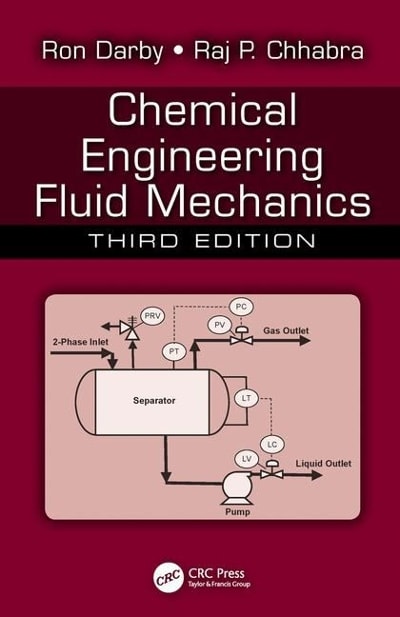Solid particles with a density of $1.4 mathrm{~g} / mathrm{cm}^{3}$ and a diameter of $0.01 mathrm{~cm}$ are
Question:
Solid particles with a density of $1.4 \mathrm{~g} / \mathrm{cm}^{3}$ and a diameter of $0.01 \mathrm{~cm}$ are fed from a hopper into a line where they are mixed with water, which is draining by gravity from an open tank, to form a slurry having $0.4 \mathrm{lb}_{\mathrm{m}}$ of solids $/ \mathrm{lb}_{\mathrm{m}}$ of water. The slurry is transported by a centrifugal pump, through a $6 \mathrm{in}$. sch 40 pipeline that is $0.5 \mathrm{mile}$ long, at a rate of $1000 \mathrm{gpm}$. The slurry can be described as a Bingham plastic, with a yield stress of $120 \mathrm{dyn} / \mathrm{cm}^{2}$ and a limiting viscosity of $50 \mathrm{cP}$.
(a) If the pipeline is at $60^{\circ} \mathrm{F}$, and the pump is $60 %$ efficient with a required NPSH (net positive suction head) of $15 \mathrm{ft}$, what horsepower motor would be required to drive the pump?
(b) If the pump is $6 \mathrm{ft}$ below the bottom of the water storage tank, and the water in the line upstream of the pump is at $90^{\circ} \mathrm{C}\left(P_{\mathrm{v}}=526 \mathrm{mmHg}\right)$, what depth of water in the tank would be required to prevent the pump from cavitating?
(c) A venturi meter is installed in the line to measure the slurry flow rate. If the maximum pressure drop reading for the venturi is $29 \mathrm{in}$. of water, what diameter should the venturi throat be?
(d) The slurry is discharged from the pipeline to a settling tank, where it is desired to concentrate the slurry to $1 \mathrm{lb}_{\mathrm{m}}$ of solids/ $/ \mathrm{l}_{\mathrm{m}}$ of water (in the underflow). Determine the required diameter of the settling tank, and the volumetric flow rates of the overflow $\left(Q_{o}\right)$ and underflow $\left(Q_{w}\right)$, in gpm.
(e) If the slurry were to be sent to a rotary drum filter instead, to remove all of the solids, determine the required size of the drum (assuming the drum length and diameter are equal). The drum rotates at $3 \mathrm{rpm}$, with $25 %$ of its surface submerged in the slurry, and operates at a vacuum of $20 \mathrm{in}$. of mercury. Lab test data taken on the slurry with $0.5 \mathrm{ft}^{2}$ of the filtermedium, at a constant flow rate of $3 \mathrm{gpm}$, indicated a pressure drop of $1.5 \mathrm{psi}$ after $1 \mathrm{~min}$ of filtration and 2.3 psi after 2 min of operation.
Step by Step Answer:

Chemical Engineering Fluid Mechanics
ISBN: 9781498724432
3rd Edition
Authors: Ron Darby, Raj P Chhabra





